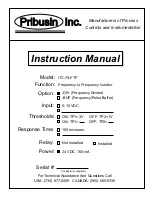
Dwg. 105133 Page 2
1 msec
insert jumper H2-3
100 microsec
insert jumper H2-2
10 microsec insert jumper H2-1
For Example, if the maximum frequency is 2000 Hz, the period is 1/2000 sec. or 500
micro seconds. Choose either 100 micro seconds or 10 micro seconds. If you were to
choose 1 msec or 10 msec, the input could not respond fast enough to your highest
input frequency and the ITC-79-FTF would not accept the input.
4. ON & OFF Thresholds:
The ITC-79-FTF has two threshold settings: one for the ON level (rising edge of the
input) and one for the OFF level (falling edge of the input). These threshold
levels must be set such that the amplitude of the input signal is larger than that
of the ON and OFF threshold levels. The ON and OFF LED's indicate which portion of
the pulse is currently being received (on frequencies above 30 Hz, both LED's appear
to be on simultaneously).
In the above example, the input signal swings from -10V to + 10V. A good threshold
level is at -8V and +8V to eliminate any possible ringing noise at the rising and
falling edges. For a dry contact input, choose an OFF Threshold above 0V, say 10-
20% of the full scale signal.
To set the Threshold levels, use a voltmeter between TP1 and TPCOM for the ON
Threshold and adjust the multiturn potentiometer until the meter reads the desired
level. Do the same for the OFF Threshold using TP2 and TPCOM.
Note:
If you are using an input range other than 10 V, the Threshold levels of
+/- 10V represent -100% to +100%
of the selected input range. For example, a
threshold of 8V represents 80 mV on a 100mV input range
setting.





























